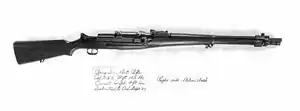| M1922 rifle | |
|---|---|
 The Model 1922 Bang rifle using the sliding muzzle-cap system. | |
| Type | Semi-automatic rifle |
| Place of origin | United States |
| Production history | |
| Designer | Søren Hansen Bang |
| Specifications | |
| Cartridge | .30-06 Springfield, 6.5×55mm Swedish |
| Action | gas-operated, rotating bolt |
| Sights | iron sights |
The Model 1922 Bang rifle is a US semi-automatic rifle designed by the Danish arms designer Søren Hansen Bang. It was a modification of the earlier Models of 1909 and Model 1911 Bang rifles, both chambered in the .30-06 Springfield round.
Overview
It was gas operated, using a sliding muzzle cup system which was blown forward by the combustion gases while the bullet emerged from the barrel. This “.256 Bang” rifle was a top candidate from 1925 to 1928 for US contracts ultimately won by the M1 Garand. Bang himself demonstrated his own models in US field trials in 1919 and 1927.[1] The Bang rifle was ultimately unsuccessful in US government testing because of its mechanical complexity and susceptibility to gas fouling of the sliding muzzle cup.
The Bang blow-forward gas system, originally developed in 1903, inspired several other weapon developments: It was used in the unsuccessful French Puteaux APX machine gun of 1904, in its direct successor the controversial St. Étienne Mle 1907 machine-gun, and in the Gewehr 41, where it suffered the same shortcomings.
Patents
- U.S. Patent 901,143, October 13, 1908, Device for Automatic Firing of Self-Loading Arms, Inventor Søren H. Bang of Copenhagen, Denmark
- U.S. Patent 1,534,486, April 21, 1925, Self-Loading Firearm, Inventor Søren H. Bang of Copenhagen, Denmark
References
- ↑ "Experimental semi-automatic rifles, 1919-1931- excluding Garand's and Pedersen's rifles - Springfield Armory National Historic Site (U.S. National Park Service)". www.nps.gov. Retrieved January 9, 2011.
External links
- material #2 from Forgotten Weapons
- Hatcher's Notebook by Julian S. Hatcher, 1952, The Stackpole Company.